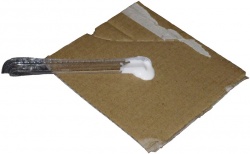Difference between revisions of "Wood glues"
(→Exterior Use: a lil more) |
(→Types of Wood Glue: bit more) |
||
| Line 12: | Line 12: | ||
Substances used as wood glue include: | Substances used as wood glue include: | ||
| − | * [[Adhesive#PVA|polyvinyl acetate]] (PVA), yellow | + | * [[Adhesive#PVA|polyvinyl acetate]] (PVA), yellow - carpenter's glue, various versions/grades available |
| + | * [[Adhesive#PVA|polyvinyl acetate]] (PVA), white - cheap, slower setting, more chance of a [[clamp]]ed joint moving before its set | ||
* Animal glues | * Animal glues | ||
| − | * [[Adhesive#Polyurethane|Polyurethane]] | + | * [[Adhesive#Polyurethane|Polyurethane]] - foams slightly, the foam fills gaps but has almost no strength. |
| − | * [[Adhesive#Cyanoacrylate|Cyanoacrylate]] (''Superglue'') used mainly for small repairs, especially by woodturners | + | * [[Adhesive#Cyanoacrylate|Cyanoacrylate]] (''Superglue'') used mainly for small repairs, especially by woodturners. Also used as varnish for small pieces |
| − | * [[Adhesive|contact cement]] for veneers | + | * [[Adhesive|contact cement]] for veneers |
| − | * [[Adhesive#hot-melt glue|hot melt]] for temporary uses | + | * [[Adhesive#hot-melt glue|hot melt]] for temporary uses, not the best bond to timber |
| − | * [[Adhesive#Epoxy Resin|Epoxy]] mainly for exterior uses | + | * [[Adhesive#Epoxy Resin|Epoxy]] mainly for structural & exterior uses |
* Other synthetic [[Adhesive#Polyester resin|resin]]s including resorcinol, urea-formaldehyde, phenol formaldehyde resin, etc. | * Other synthetic [[Adhesive#Polyester resin|resin]]s including resorcinol, urea-formaldehyde, phenol formaldehyde resin, etc. | ||
Revision as of 23:50, 21 February 2013
Most wood glues need to be clamped while the glue dries to achieve maximum bond strength. Very little glue is needed to bond pieces of wood together.
Types of Wood Glue
Many substances have been used as glues. The most common wood glue is polyvinyl acetate (PVA), also known as "carpenter's glue" or "Yellow glue". The white version of polyvinyl acetate is also used on wood. Epoxy is sometimes used where bond failure could cause injury.
Traditionally, animal glues were ubiquitous, especially hide glue, which is still used in lutherie and restoration.
Polyurethane glue (trade names include Gorilla Glue and Excel) is becoming increasingly popular, especially where water resistance is required, although water-resistant PVAs are available .
Substances used as wood glue include:
- polyvinyl acetate (PVA), yellow - carpenter's glue, various versions/grades available
- polyvinyl acetate (PVA), white - cheap, slower setting, more chance of a clamped joint moving before its set
- Animal glues
- Polyurethane - foams slightly, the foam fills gaps but has almost no strength.
- Cyanoacrylate (Superglue) used mainly for small repairs, especially by woodturners. Also used as varnish for small pieces
- contact cement for veneers
- hot melt for temporary uses, not the best bond to timber
- Epoxy mainly for structural & exterior uses
- Other synthetic resins including resorcinol, urea-formaldehyde, phenol formaldehyde resin, etc.
Exterior Use
Wood glues intended for exterior use vary in their suceptibility to water. But even totally waterproof glue is best avoided in most outdoor uses, as:
- wood swells & shrinks outdoors
- most outdoor glues aren't entirely waterproof
- glue can sometimes hinder drying & preservative penetration
Glues:
- PVA (exterior grade)
- Polyurethane - survives frequent showers but not constant wet or damp
- Hide glue
- Cyanoacrylate
- Contact cement
- Hot melt - some are fully waterproof, not pva. not the strongest
- Epoxy - totally completely waterproof
- Resorcinol
- Urea-formaldehyde
- Phenol formaldehyde resin
Trade & other names
- PVA, yellow - carpenter's glue, yellow glue
- PVA, white - elmer's, white glue,
- Polyurethane - Deckbond, Gorilla Glue, Excel
- Hide glue - animal glue,
- Cyanoacrylate - Superglue, crazy glue
- Contact cement
- Hot melt
- Epoxy - Araldite
- Resorcinol
- Urea-formaldehyde
- Phenol formaldehyde resin
References
Patrick Spielman (1986). Gluing and Clamping: A Woodworker’s Handbook. Sterling Publishing. ISBN 0-8069-6274-7
